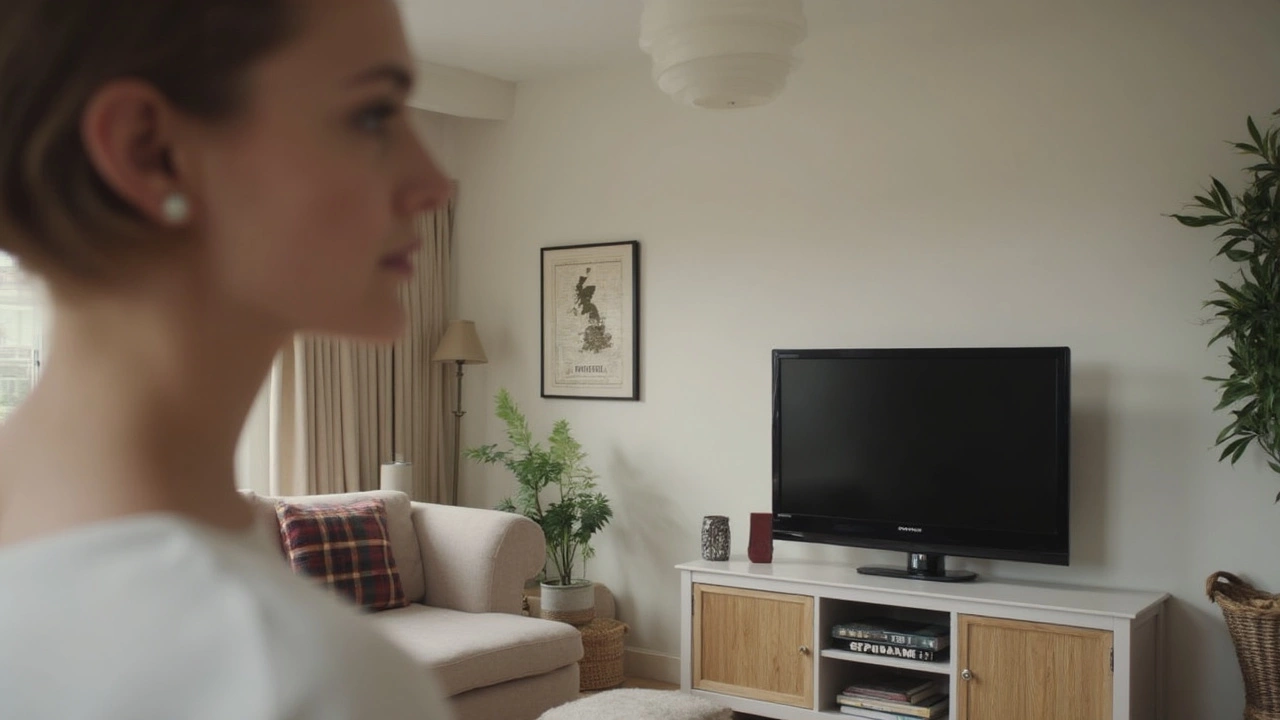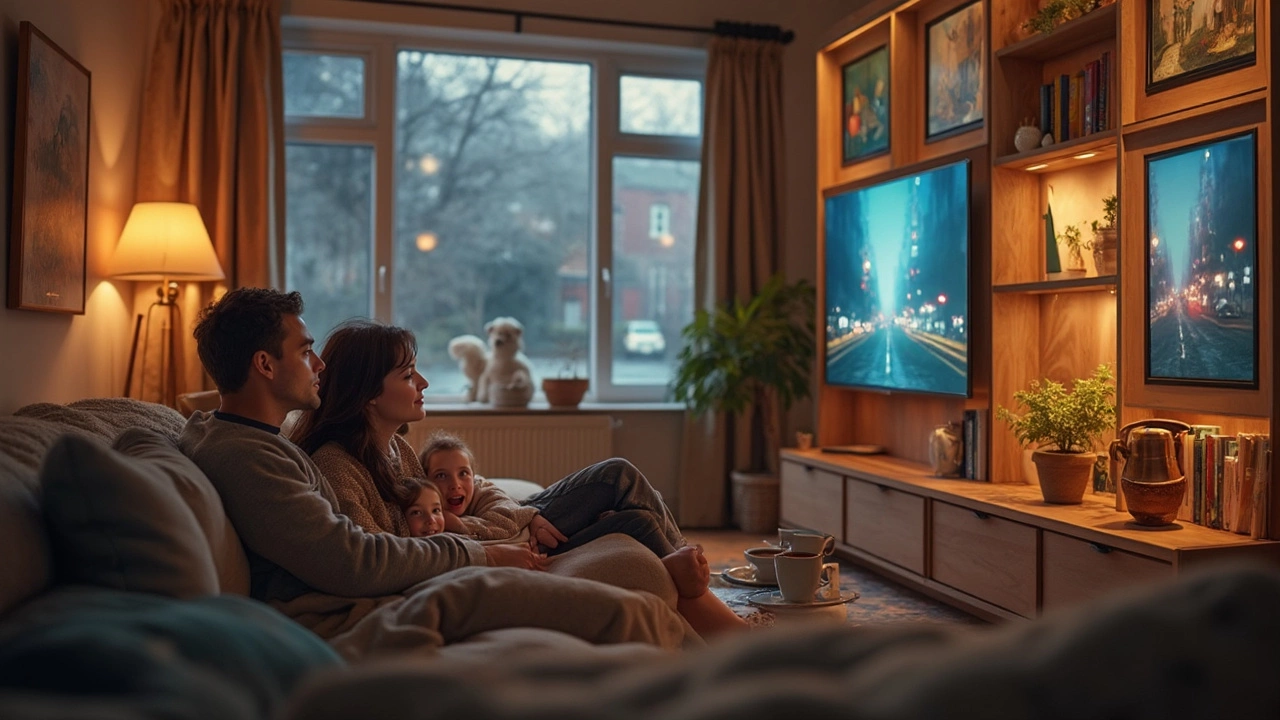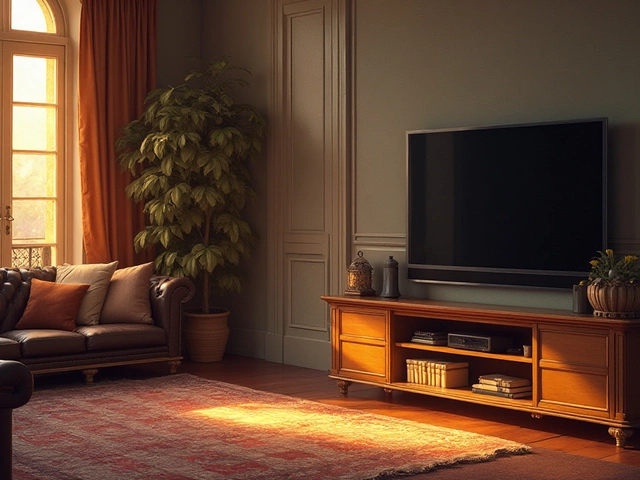Ever watched a movie and felt your neck ache halfway through? Chances are, your TV isn’t at the right height. Getting a 65 inch TV up on a stand (or mount) is more than just plugging it in. You want your eyes lined up with the center of the screen when you're sitting down. Not only does this help your neck, but it also makes the picture look way better—colors and details pop when you’re looking at the right angle.
Most folks don’t realize it, but a 65 inch TV sits taller and wider than you think when you haul it out of the box. Slapping it on the closest piece of furniture won’t cut it. For a proper setup, you need to think about your seat height, the distance from the screen, and even how much you recline on movie night. Miss this step and you risk hours of discomfort or a nice TV you never truly enjoy.
- Getting the Fundamentals: Why Height Matters
- How to Calculate the Best TV Height
- Real-World Tips: Working with Stands and Walls
- Common Mistakes and How to Dodge Them
Getting the Fundamentals: Why Height Matters
Here’s the deal: The right viewing height for your 65 inch TV can totally change your whole setup, even if your TV is the nicest thing in the room. When your screen sits too high or too low, your neck and eyes pay the price. Ever wonder why your neck hurts after a movie marathon? It’s probably not your couch—it’s your TV position messing things up.
Experts in home theater design say the sweet spot is for your eyes to hit the center of the screen when you’re sitting. For most people in a living room, that means the middle of the TV should be about 42 inches (107 cm) off the floor—giving the most comfortable view for most couches and chairs. This ‘eye level’ isn’t a wild guess; it’s based on how most folks actually sit. The idea is to let you enjoy all that 4K or HDR detail straight on, not from above or below, which can make colors look weird or give you glare from lights.
Here’s a quick look at why this matters, especially for a 65 inch TV:
- Picture Quality: TV screens, especially bigger ones, look their best when you’re facing them straight on. The farther off-center you get, the more you lose brightness and accurate colors.
- Comfort: Watching with your head tilted up or down for hours leads to stiff necks and headaches. Lining the TV up with your eyes cuts down on aches.
- Immersion: When the action is at your eye level, it’s way easier to get lost in the show or game.
TV manufacturers often recommend a center-of-screen height for all their models, not just for showrooms. The numbers aren’t random—they’re all about you kicking back and actually enjoying your screen. Here’s a table with the recommended center-of-screen height for common TV sizes:
| TV Size (inches) | Recommended Center Height (inches) | Recommended Center Height (cm) |
|---|---|---|
| 55 | 42 | 107 |
| 65 | 42 | 107 |
| 75 | 44 | 112 |
So the next time you set up your TV stand, remember: lining things up at eye level isn't just a tech geek thing. It means a better picture, a comfier night, and a viewing setup that actually makes the most of that 65 inch TV.
How to Calculate the Best TV Height
Measuring the best viewing height for your 65 inch TV is easier than you think, and it makes a huge difference in comfort. The center of your screen should be at your eye level when you’re sitting in your usual spot. For most living rooms, that’s about 42 inches from the floor to eye level for an adult seated on a couch. But don’t guess—grab a tape measure and find out for yourself, since everyone’s couch is different.
Here’s a simple way to get it right every time:
- Sit where you’ll watch TV the most. Measure from the floor up to your eyes. Jot that number down.
- Your 65 inch TV is about 32 inches tall (screen only, not counting the stand). Divide the height of your TV by 2—so about 16 inches. The goal is to have the center of the screen at your eye level.
- Decide where your TV stand’s surface should sit. Subtract 16 inches from your eye-level measurement. That’s about where the base of your TV should start.
If you want to double-check your math, here’s a quick table showing standard setups:
| Seat Height (Eye Level) | TV Center Height | TV Stand Height (approx.) |
|---|---|---|
| 42 inches | 42 inches | 26 inches |
| 38 inches (low couch) | 38 inches | 22 inches |
| 46 inches (high seat) | 46 inches | 30 inches |
According to the Society of Motion Picture and Television Engineers (SMPTE), "The optimum position for the center of the screen is directly at the viewer’s eye level when seated".
SMPTE recommends that the vertical viewing angle should not be more than 15 degrees above or below eye level for comfortable viewing.
Keep in mind, mounting a 65 inch TV too high—like above a fireplace—can lead to neck pain and a washed-out picture. Eye-level is always the sweet spot. If you sit in a recliner, adjust the numbers a bit since you’re leaning back. When in doubt, use painter’s tape to mark out the planned TV spot on the wall first before lifting anything heavy.

Real-World Tips: Working with Stands and Walls
If you’ve got a 65 inch TV, picking the right TV stand or figuring out wall mounting can make all the difference. Let’s break down some tried-and-true tips for both situations.
TV Stands aren’t all made equal. Measure the height of your own seating, then check if the TV stand keeps the center of the TV screen at eye level (usually around 42 inches from the floor for most couches). A TV stand that’s too tall or too short ruins the whole movie night vibe, so check those details before you buy. Stands with adjustable shelves make life easier if you want to fine-tune the height, too.
Got a ton of cables and a game console or soundbar? Pick a stand wide enough to match the 65 inch TV (about 57 inches wide) and deep enough to hold your other devices. Stands that are at least as wide as the TV prevent accidental tipping—especially if kids or pets are around.
- For most living rooms, stands between 24 to 26 inches in height hit that sweet spot.
- Always put your TV at least a couple of inches away from the wall for airflow—TVs hate getting hot.
- If you’re using a soundbar, check it doesn’t block the screen bottom.
Wall Mounting a big screen like this sounds scary, but it isn’t rocket science. Use a mount that’s rated for both the size and weight of your particular model—specs are always in the manual or online. The center of the screen—where your eyes naturally rest—should line up with your main seating area.
Here’s a quick cheat sheet (assuming you’re sitting on a standard couch and your eye level is about 42 inches from the floor):
| TV Size | Eye Level | TV Center Height |
|---|---|---|
| 65 inch | 42 inches | Measured to TV center |
Don’t forget to use a level—crooked TVs are an eyesore. If you need to drill into drywall, always hit a stud (stud finders are cheap and save you grief). If you have plaster walls or want to mount above a fireplace, look up instructions for your wall type; safety matters more than convenience here.
If you move seats often or have recliners, consider a full-motion mount. You can tilt or adjust it, so everyone in the room gets the best view. And here’s a tip: always hide your cables. Raceways and cable management boxes aren’t expensive, but they make the setup look clean and pro, not like you stuffed everything behind the TV and hoped for the best.
Common Mistakes and How to Dodge Them
People mess up their 65 inch TV setup more often than you’d think. Here’s where things usually go sideways—and how you can skip the headache.
- Placing the TV Too High: The classic move is plonking your TV on a tall dresser or mounting it above a fireplace. Big mistake. Eye strain and stiff necks are almost guaranteed. The sweet spot is having the TV’s center at your sitting eye level—usually about 42 inches from the floor, but adjust for your seat height.
- Ignoring the Stand Height: Not all TV stands work for all TVs. Putting a 65 inch screen on a short cabinet? You’ll crane your neck down. Too tall, and you’re looking up. Always measure the stand plus the TV, not just the stand itself.
- Forgetting Viewing Distance: People focus so much on height, they forget how far back they’ll actually sit. The typical viewing distance for a 65 inch TV is about 8 to 10 feet. Any closer and you’ll notice pixels; any farther and the screen feels small.
- Glare Blindness: Windows, lamps, and shiny surfaces mess with your picture more than you’d think. Before you set your TV on a stand, check for reflections at different times of day. A simple curtain or tilt-adjustable mount can work wonders.
- No Cable Management: Sloppy wires can turn even the fanciest setup into a hassle. Use clips or Velcro straps to keep cords out of sight and untangled from day one.
Still not sure if your setup’s right? Here’s a quick cheat sheet for a typical living room:
| Seat Height (floor to eyes) | Ideal TV Center Height | TV Stand Height (approx) |
|---|---|---|
| 18" (low sofa) | 38" | 20" |
| 22" (standard couch) | 42" | 24" |
| 26" (high seat or barstool) | 46" | 28" |
Measure twice, move your 65 inch TV once—it’ll save you from annoying tweaks and sore muscles later. Keep these pointers in mind, and your movie nights will thank you.



